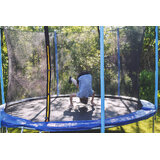Home Trampoline Setup Checklist: 5 Key Considerations for Safety and Enjoyment
Author: Jump Star Trampolines Date Posted:5 December 2023

As a beloved addition to many Australian backyards, trampolines provide endless fun and entertainment for the whole family. However, setting up a home trampoline requires careful planning to ensure a safe and enjoyable experience for all users. In this user-friendly checklist, we'll guide you through the essential factors to consider when setting up a trampoline at home, from location and safety to maintenance and additional features.
By ticking off these key considerations during the setup process, you'll not only create a trampoline space tailored to your family's needs but also maximise the safety and longevity of your investment. So, let's jump into our top five trampoline setup tips to help you confidently build the perfect backyard playground for your loved ones!
1. Choose the Ideal Location for Your Trampoline
- Evaluate Your Backyard Space: The first step in setting up a home trampoline is to assess your available space. Ensure that there is enough room for the trampoline size you've chosen while taking into consideration future growth of your family or potential landscaping changes. Additionally, consider leaving a buffer zone of at least 1.5 - 2 metres around your trampoline for added safety.
- Surface Preparation: Set up your trampoline on a flat, stable surface. While grass is the most common and safest option, you can also use sand or rubber mulch for better shock absorption. Avoid placing your trampoline on concrete, as this significantly increases the risk of injuries.
- Positioning and Sun Exposure: Choose a spot with minimal sun exposure to prevent possible UV damage to your trampoline and to provide a cooler jumping experience during the hot Australian summers. Additionally, positioning your trampoline in a shady area can extend the lifespan of its components, such as the jumping mat and safety padding.
- Avoid Obstructions and Hazards: Make sure that there are no overhanging branches, power lines, or other obstacles above or around your trampoline. A clear space helps reduce the risk of accidents and ensures a safe jumping experience.
2. Trampoline Assembly and Safety Systems
- Follow the Manufacturer's Instructions: Assemble your trampoline according to the manufacturer's guidelines to ensure its structural integrity and safety features are properly installed. This includes correctly attaching the jumping mat, springs, safety pads, and the enclosure net, as well as checking for any missing parts or defects.
- Springs and Jumping Mat Installation: When attaching the springs, always use a spring tool to minimise the risk of injury. Ensure the springs are evenly spaced around the frame and securely attached to the trampoline mat. The jumping mat should be tightly stretched and free of defects such as holes and fraying.
- Safety Enclosure Net: A safety net is a vital component of home trampoline safety. Make sure it's securely attached to the trampoline frame and has no gaps or tears. Regularly inspect the net for signs of wear and tear, and replace it as recommended by the manufacturer.
- Safety Padding: Attach the safety padding over the springs and frame to prevent contact-related injuries. Ensure that the padding covers all springs and frame sections completely and is securely fastened.
3. Routine Maintenance and Inspections
- Regular Inspection: Perform routine inspections of the trampoline components, looking for any damage or signs of wear. Check the frame, springs, jumping mat, safety net, and padding, and address any issues immediately. Replace worn-out or damaged parts as needed to maintain the safety and performance of your trampoline.
- Clean and Protect: Keep your trampoline clean by regularly wiping down the jumping mat, safety pads, and frame with a mild detergent. Remove leaves, dust, and debris to prevent the buildup of dirt and grime that can damage your trampoline over time. You can also invest in a trampoline cover to provide additional protection from weather elements, such as sun, rain, and wind.
- Prevent Rust and Corrosion: Check your trampoline frame and springs for any signs of rust or corrosion. This can weaken the structural integrity of your trampoline, posing a safety risk. Regularly apply a rust inhibitor spray or touch-up paint to protect metal components and increase the longevity of your trampoline.
4. Establish Safe Jumping Rules and Supervision
- One Jumper at a Time: Limit the number of jumpers on the trampoline at any given time to minimise collision risk. Although it can be tempting to allow multiple children to jump together, it’s safer to enforce a one-at-a-time rule.
- Age Limitations and Adult Supervision: Ensure that children under six years old do not use trampolines that are designed for older kids or adults. Adult supervision for younger children is crucial to ensure safe jumping practices and to avoid potential injuries.
- Safe Jumping Techniques: Educate your family on safe trampoline jumping techniques, such as keeping their feet and knees slightly bent and maintaining control at all times. Avoid potentially dangerous manoeuvres like flips and somersaults without proper training and supervision.
- Limit Access: To ensure that children only use the trampoline when an adult is present, consider installing a lock on the entrance of the safety net or removing the ladder when not in use.
5. Enhance Your Trampoline Experience with Accessories
- Anchor Kit: To prevent your trampoline from being dislodged or tipped during high winds, invest in an anchor kit. These kits include strong straps and stakes that secure your trampoline to the ground, providing an extra layer of safety and stability.
- Ladder: A trampoline ladder allows for easy and safe access to the jumping surface, especially for younger children. Opt for a ladder with non-slip steps and durable construction for added safety.
- Basketball Hoop Attachment: Turn your trampoline into a fun and interactive sports zone by adding a basketball hoop attachment. This provides a new dimension to trampoline play and can improve coordination and agility.
- Shade Cover: A shade cover can provide UV protection and a cooler jumping experience during hot summer days. Make sure to choose a durable shade cover designed specifically for trampoline use.
Enjoy Safe and Limitless Fun with the Perfect Home Trampoline Setup
By considering these five essential factors during the setup of your home trampoline, you'll not only ensure a safe and enjoyable jumping experience but also maximize the longevity and performance of your investment. From choosing the ideal location and assembling your trampoline correctly, to routine maintenance, safe jumping practices, and enhancing your experience with accessories - taking these steps will create the perfect recipe for endless backyard fun.
Discover the best in trampoline quality, safety, and innovative accessories at Jump Star Trampolines. Browse our extensive range and create the ultimate backyard playground tailored to your family's needs. Together, let's jump-start your family's best trampoline adventures in safety and style.






